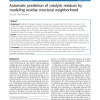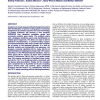123 search results - page 15 / 25 » Functional site prediction selects correct protein models |
BMCBI
2010
14 years 12 months ago
2010
Background: Prediction of catalytic residues is a major step in characterizing the function of enzymes. In its simpler formulation, the problem can be cast into a binary classific...
GCB
1998
Springer
15 years 4 months ago
1998
Springer
Analysis of a newly sequenced bacterial genome starts with identification of protein-coding genes. Functional assignment of proteins requires the exact knowledge of protein N-term...
BMCBI
2006
14 years 12 months ago
2006
Background: The main aim of this study was to develop and implement an algorithm for the rapid, accurate and automated identification of paths leading from buried protein clefts, ...
106
click to vote
BMCBI
2005
14 years 11 months ago
2005
Background: Currently, the PDB contains approximately 29,000 protein structures comprising over 70,000 experimentally determined three-dimensional structures of over 5,000 differe...
BMCBI
2008
14 years 12 months ago
2008
Background: Several eukaryotic proteins associated to the extracellular leaflet of the plasma membrane carry a Glycosylphosphatidylinositol (GPI) anchor, which is linked to the C-...


